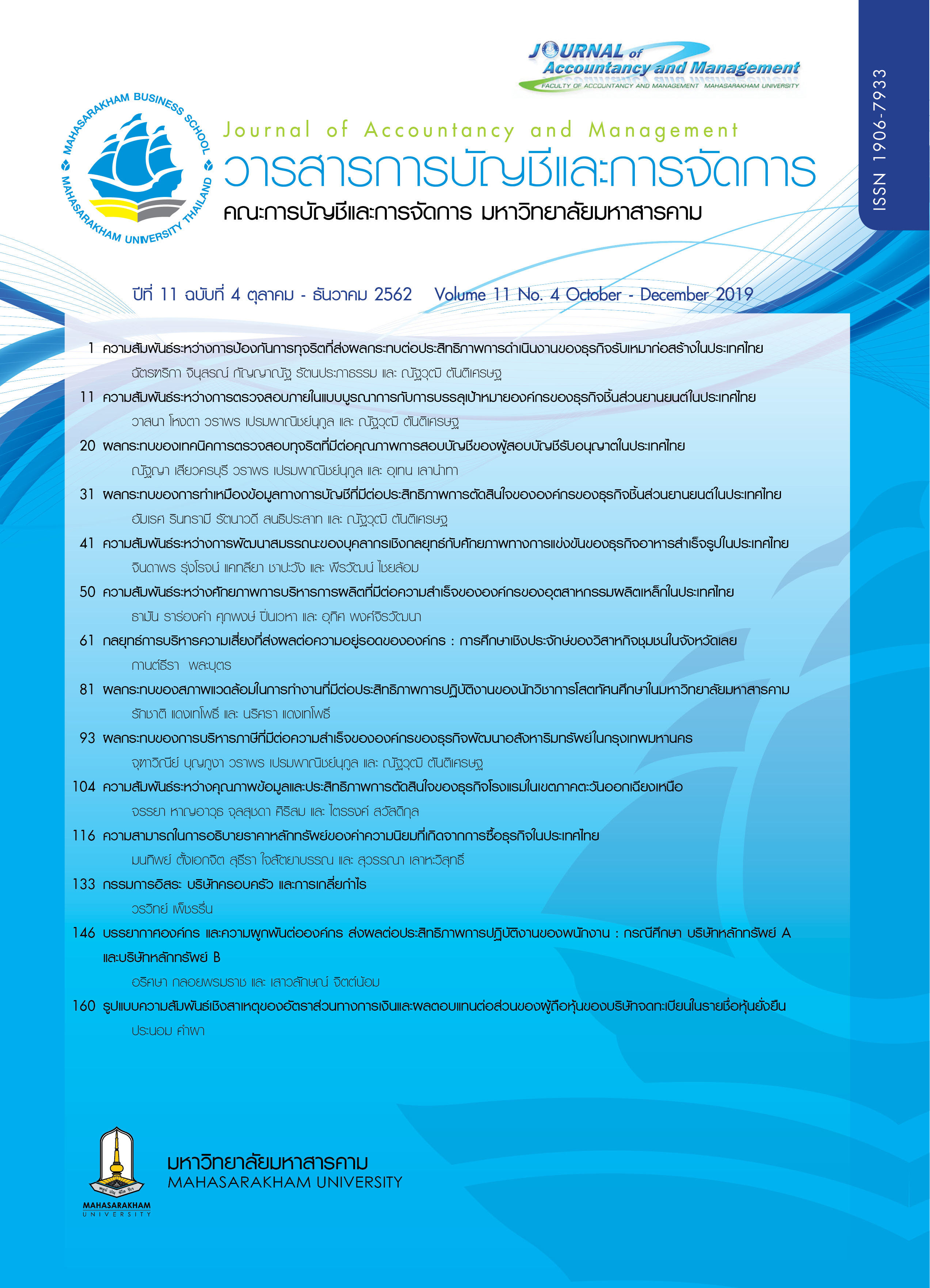ความสัมพันธ์ระหว่างศักยภาพการบริหารการผลิตที่มีต่อความสำเร็จขององค์กรของอุตสาหกรรมผลิตเหล็กในประเทศไทย
Main Article Content
บทคัดย่อ
การวิจัยนี้มีวัตถุประสงค์ เพื่อศึกษาความสัมพันธ์ระหว่างศักยภาพการบริหารการผลิตที่มีต่อความสำเร็จขององค์กรของอุตสาหกรรมผลิตเหล็กในประเทศไทย โดยใช้แบบสอบถามเป็นเครื่องมือ ในการเก็บรวบรวมข้อมูลจากผู้บริหารฝ่ายการผลิต จำนวน 127 คน สถิติที่ใช้ในการวิเคราะห์ข้อมูล ได้แก่ การวิเคราะห์สหสัมพันธ์แบบพหุคูณ และการวิเคราะห์ความถดถอยเชิงพหุคูณ ผลการวิจัย พบว่า พบว่า 1) ศักยภาพการบริหารการผลิต ด้านการควบคุมการผลิต มีความสัมพันธ์และผลกระทบเชิงบวกกับความสำเร็จขององค์กรโดยรวม ด้านงานสำเร็จทันเวลา ด้านผลงานได้มาตรฐาน และด้านนวัตกรรมดำเนินงาน และ 2) ศักยภาพการบริหารการผลิต ด้านการควบคุมการผลิต และด้านการควบคุมคุณภาพ มีความสัมพันธ์และผลกระทบเชิงบวกกับความสำเร็จขององค์กร ด้านการใช้ทรัพยากรอย่างมีคุณค่า ดังนั้น ผู้บริหารฝ่ายการผลิตของอุตสาหกรรมเหล็กในประเทศไทย ควรมุ่งเน้นและให้ความสำคัญกับกระบวนการผลิตที่มีการควบคุมกระบวนการผลิตและการควบคุมคุณภาพการผลิตอย่างมีประสิทธิภาพและประสิทธิผล เพื่อให้เกิดความสำเร็จในการบริหารจัดการการผลิต ให้ทันต่อเวลา ได้รับมาตรฐานเป็นที่ยอมรับ โดยใช้ทรัพยากรให้คุ้มค่าและเกิดประโยชน์สูงสุด เพื่อเพิ่มโอกาสทางการผลิตและเสริมสร้างศักยภาพทางการแข่งขันเพื่อความสำเร็จขององค์กรอย่างต่อเนื่อง
Downloads
Article Details
บทความที่ได้รับการตีพิมพ์เป็นลิขสิทธิ์ของวารสารการบัญชีและการจัดการ
ข้อความที่ปรากฏในบทความแต่ละเรื่องในวารสารวิชาการเล่มนี้เป็นความคิดเห็นส่วนตัวของผู้เขียนแต่ละท่านไม่เกี่ยวข้องกับมหาวิทยาลัยมหาสารคาม และคณาจารย์ท่านอื่นๆในมหาวิทยาลัยฯ แต่อย่างใด ความรับผิดชอบองค์ประกอบทั้งหมดของบทความแต่ละเรื่องเป็นของผู้เขียนแต่ละท่าน หากมีความผิดพลาดใดๆ ผู้เขียนแต่ละท่านจะรับผิดชอบบทความของตนเองแต่ผู้เดียว
เอกสารอ้างอิง
จักพงศ์ ขวัญแก้ว และรักพงศ์ วงศาโรจน์. (2553). การบริหารการผลิตและการปฏิบัติการที่มีผลต่อประโยชน์ที่ได้รับของบริษัทผู้ผลิตชิ้นส่วนรถยนต์. วารสารบริหารธุรกิจศรีนครินทรวิโรฒ มหาวิทยาลัยศรีนครินทรวิโรฒ ประสานมิตร, 2(1) : 109–134
บุญชม ศรีสะอาด.(2556). การวิจัยเบื้องต้น. พิมพ์ครั้งที่ 9. กรุงเทพมหานคร : สุรีวิยาสาส์น.
พัชรี สุวรรณศรี และสุภัทณี เปี่ยมสุวรรณกิจ. (2554). ประชาคมเศรษฐกิจโลก..ค้นเมื่อ 29 กุมภาพันธ์ 2559.จาก
ยุทธ์ ไกยวรรณ์ และพงศ์ หรดาล.(2554). การบริหารการผลิต. กรุงเทพ ฯ: ศูนย์สื่อเสริม.
ราม ปิยะเกตุ. (2561). พัฒนาการของผู้ประกอบการพาณิชย์อิเล็กทรอนิกส์. ค้นเมื่อ 29 กุมภาพันธ์ 2561. จาก https://www.dbd.go.th/images/content/total_01.html.
ศูนย์วิจัยกสิกร. (2559). แนวโน้มอุตสาหกรรมผลิตเหล็ก. ค้นเมื่อ 29 กุมภาพันธ์ 2559. จาก https://www.kasikornresearch.com
Aaker, D. A., Kumar, V. & Day, G. S. (2001). Marketing research. New York : John Wiley & Son.
Black, K. (2006). Business statistics for contemporary decision making. USA : John Wiley & Son, Inc.
Emerson, Harrington. (1931). The twelve principles of efficiency. New York : The Engineering Magazine,
Nunnally, J. C. & I. H. Bernstein. (1994). Psychometric theory New York : McGraw – Hill.
Nunnally, J. C. (1987).Psychometric theory (2nd ed.). New York, NY: McGraw-Hill.
Pun, K. F., & Anthony, S. W. (2005). A performance measurement paradigm for integrating strategy formulation : A review of systems and frameworks, International Journal of Management Reviews. 7(1) : 49-71.
Wisner, J. D., Leong, G. K., & Tan, K. C. (2005). Principle of supply chain management : A balanced approach. South – Western. USA: Thomson.
William & J. Stevenson. (2002). Operations management. McGraw-Hill.


